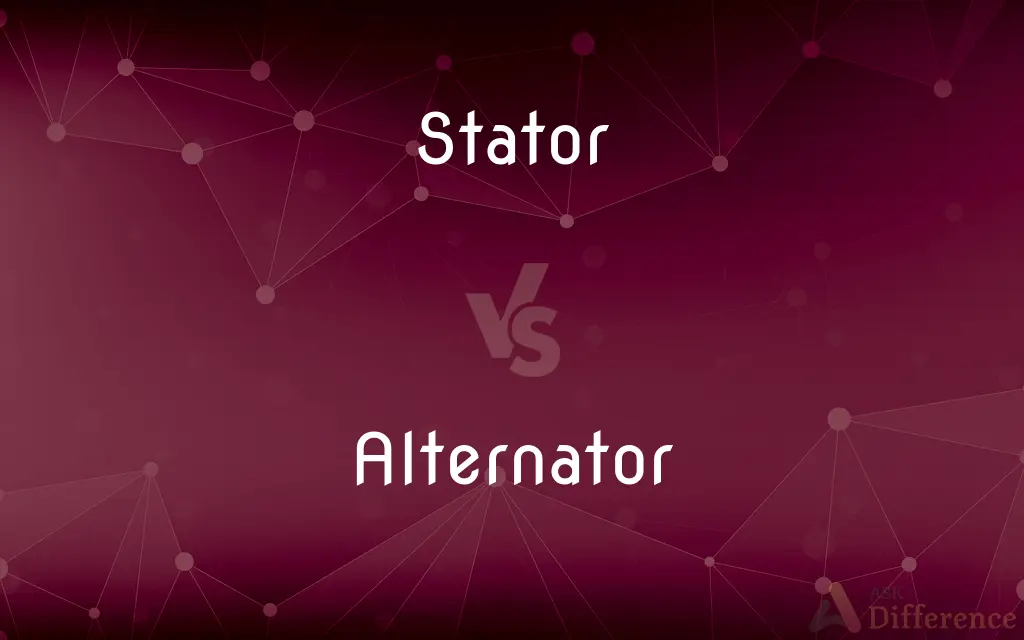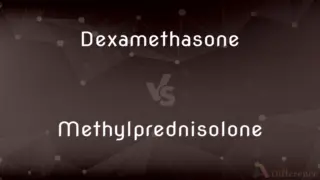Stator vs. Alternator — What's the Difference?
By Maham Liaqat & Fiza Rafique — Updated on March 25, 2024
The stator is a stationary part of a rotary system, while an alternator is a device that converts mechanical energy to electrical energy.

Difference Between Stator and Alternator
Table of Contents
ADVERTISEMENT
Key Differences
The stator is a key component in many electromechanical devices, serving as the stationary part of a rotary system, such as in electric motors or generators. It typically consists of coils or windings and works in conjunction with a rotating component, known as the rotor, to induce electricity or motion. In contrast, an alternator is a specific type of generator used primarily in automotive applications to charge the battery and power the electrical system when the engine is running. It consists of both a stator and a rotor, among other components.
In the context of an alternator, the stator is the part that remains stationary and contains coils of wire. When the engine runs, the alternator's rotor, driven by a belt connected to the engine, spins inside the stator. This movement generates an alternating current (AC) in the stator's windings. The alternator as a whole, which includes the stator, rotor, and other components like the voltage regulator, converts this AC into a direct current (DC) to charge the vehicle's battery and power its electrical systems.
The primary role of the stator in various devices is to provide a magnetic field against which the rotor can move to produce electricity or mechanical force. In contrast, the alternator's role is to serve as a power generator, specifically designed to meet the demands of automotive electrical systems, among other applications. While the stator is a component that can be found in many different devices, including alternators, the alternator refers to the complete unit that performs the function of converting mechanical energy into electrical energy.
Stators are found in a broad range of devices beyond alternators, including other types of generators, electric motors, and pumps, where they may serve different functions based on the device's specific requirements. On the other hand, alternators are primarily associated with automotive and similar applications, though they can also be found in industrial and marine environments.
In summary, while the stator is a crucial part of an alternator, serving to produce an electrical current through electromagnetic induction, the alternator encompasses the stator, rotor, and additional components to fulfill its role as a generator. The distinction lies in the stator being a component that can exist in various devices and the alternator being a specific device that includes a stator as one of its essential parts.
ADVERTISEMENT
Comparison Chart
Definition
Stationary part of a rotary system in electromechanical devices.
Device converting mechanical energy to electrical energy.
Composition
Typically consists of coils or windings.
Includes a stator, rotor, voltage regulator, among other parts.
Function
Provides a magnetic field for the rotor.
Charges the vehicle's battery and powers the electrical system.
Application
Found in electric motors, generators, and pumps.
Primarily used in automotive applications.
Role in Alternators
Part of an alternator, producing an electrical current.
The complete unit that includes the stator and other components.
Compare with Definitions
Stator
Utilizes windings or coils to produce an electromagnetic field.
The stator's coils are crucial for the electromagnetic induction process.
Alternator
Converts mechanical energy from the engine to electrical energy for the battery and electrical systems.
The alternator is key to keeping the car's battery charged.
Stator
The non-moving part of a rotary system in devices like motors and generators.
The motor's efficiency depends on the interaction between the rotor and the stator.
Alternator
Typically driven by a belt connected to the engine, allowing it to generate power as the engine runs.
A loose alternator belt can lead to poor battery charging.
Stator
Converts electrical energy to mechanical energy or vice versa, depending on the device.
In the generator, the stator converts mechanical energy into electrical energy.
Alternator
Generates alternating current (AC) and converts it to direct current (DC) for automotive use.
The car's alternator includes a rectifier to convert AC to DC.
Stator
Stators can vary in design based on their specific application and device requirements.
The wind turbine's stator is designed to maximize electrical output from wind energy.
Alternator
Works with the battery and voltage regulator to maintain the vehicle's electrical system.
The alternator's efficiency directly impacts the vehicle's electrical performance.
Stator
Used in various devices beyond alternators, including HVAC systems and pumps.
The pump's stator ensures the proper flow and pressure of the fluid.
Alternator
Requires regular maintenance and can be a common point of failure in vehicles.
A failing alternator will often lead to dimming lights and battery drain.
Stator
The stator is the stationary part of a rotary system, found in electric generators, electric motors, sirens, mud motors or biological rotors. Energy flows through a stator to or from the rotating component of the system.
Alternator
An alternator is an electrical generator that converts mechanical energy to electrical energy in the form of alternating current. For reasons of cost and simplicity, most alternators use a rotating magnetic field with a stationary armature.
Stator
The stationary part of a motor, dynamo, turbine, or other working machine within which a rotor turns.
Alternator
An electric generator that produces alternating current.
Stator
The stationary part of a motor or other machine.
Alternator
(electrical engineering) An electric generator which produces alternating current through mechanical means.
Stator
A stationary part in or about which another part (the rotor) revolves, esp. when both are large;
Alternator
An electric generator or dynamo for producing alternating currents.
Stator
Mechanical device consisting of the stationary part of a motor or generator in or around which the rotor revolves
Alternator
An old term for an electric generator that produces alternating current (especially in automobiles)
Common Curiosities
Is every alternator the same in all vehicles?
While the basic function of alternators is consistent, their size, capacity, and design can vary significantly depending on the vehicle's requirements.
Do electric vehicles use alternators?
Electric vehicles (EVs) do not use traditional alternators as they rely on regenerative braking and other systems to recharge their batteries.
How can you tell if an alternator is failing?
Signs of a failing alternator include dimming lights, electrical malfunctions, battery drain, and sometimes a distinctive whining noise.
Can an alternator be repaired, or does it need to be replaced?
Some alternator issues can be repaired, such as replacing the voltage regulator or bearings, but often a complete replacement is more cost-effective.
Can a stator function on its own?
The stator cannot function independently in the context of power generation; it needs to interact with a rotor to produce or utilize electromagnetic induction.
What happens if the stator fails?
A failing stator can lead to reduced efficiency, malfunctioning, or complete failure of the device it is part of, whether it's a motor, generator, or alternator.
Are there different types of alternators?
Yes, there are several types of alternators, including brushless alternators and those with different configurations of windings to meet specific power requirements.
Is the stator in a washing machine the same as in an alternator?
While the principle of operation is similar, the stator in a washing machine is designed specifically for the appliance's requirements and may not be interchangeable with an alternator's stator.
How long does an alternator typically last?
Alternators can last 7 years or more, but their lifespan can vary widely depending on usage, vehicle condition, and maintenance.
Can the stator affect the performance of an electric motor?
Yes, the design and condition of the stator are crucial for the efficient performance of an electric motor.
Share Your Discovery

Previous Comparison
Dexamethasone vs. Methylprednisolone
Next Comparison
Scythe vs. HoeAuthor Spotlight
Written by
Maham LiaqatCo-written by
Fiza RafiqueFiza Rafique is a skilled content writer at AskDifference.com, where she meticulously refines and enhances written pieces. Drawing from her vast editorial expertise, Fiza ensures clarity, accuracy, and precision in every article. Passionate about language, she continually seeks to elevate the quality of content for readers worldwide.














































